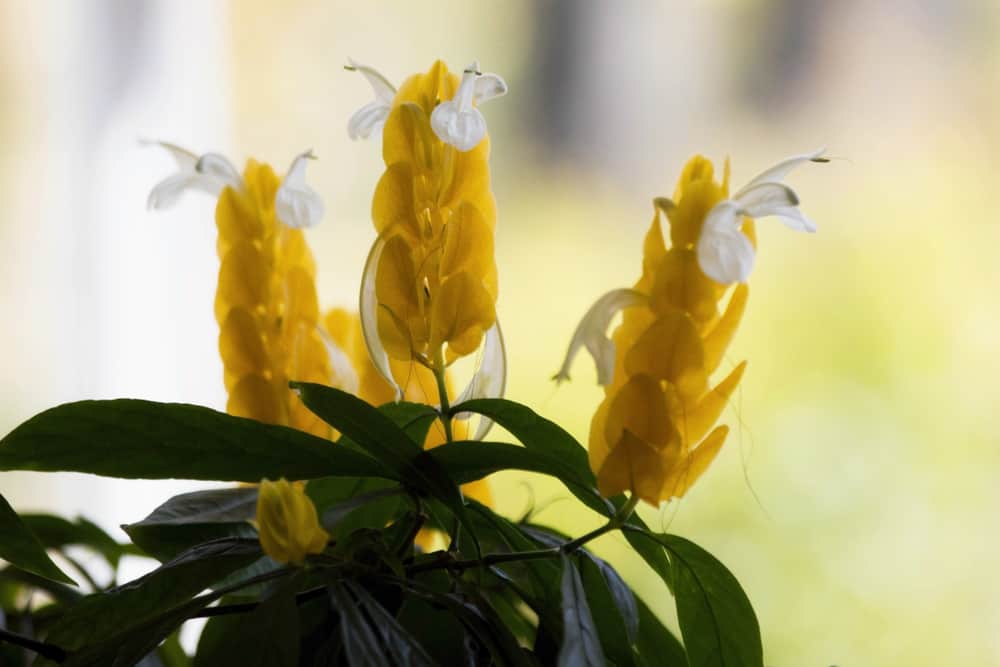HousePlantJoy is supported by our audience. When you purchase through one of our links, we may earn a small affiliate commission. As an Amazon Associate I earn from qualifying purchases. Your cost is not affected.
==================
Embark on a journey of shrimp plant care, where the secrets of tending to the vibrant Justicia Brandegeeana unfold. Hailing from Mexico, these captivating plants offer more than beauty – they provide a touch of exotic allure to your space. Join us as we explore the world of shrimp plant cultivation, revealing simple techniques, propagation insights, and solutions to common challenges, ensuring your garden blossoms with effortless elegance.
Unlock the Secrets of Proper Shrimp Plant Care
- Taking care of your Shrimp Plant doesn’t have to feel like cracking a complex code. In fact, with the captivating beauty and unique features this plant brings to the table, you might find yourself willingly investing even more time in its care.
Explore the World of Justicia Brandegeeana:
- Commonly known as the Mexican shrimp plant or bogus jump, this evergreen shrub belongs to the Justicia genus of the Acanthaceae family.
- Originally hailing from Mexico, it has comfortably naturalized in the sunny state of Florida.
- Standing at a height of up to one meter with slender branches, it boasts oval, green leaves that measure between 3 and 7.6 cm in length.
The Shrimp Plant Unveiled:
- Earns its moniker from the graceful 3-4 inch spikes of vibrant bracts that adorn the plant throughout the year.
- It’s like nature’s way of adding a touch of flair to your surroundings.
Simple Techniques for Thriving Shrimp Plants:
- Let’s unravel the secrets and discover the simple yet effective techniques to ensure your Shrimp Plant thrives in all its glory.
Discover the Fascinating World of Shrimp Plants
Witness a vibrant display as the flashy bracts unfold in a spectrum ranging from reddish-brown and coppery pink to a dazzling yellow. For optimal vibrancy, bask these plants in abundant sunlight. Find the perfect spot, preferably in a bright area where it can soak in some direct sunlight. Don’t be too concerned about the petite, white blooms that emerge towards the end of the bracts; they are fleeting, adding a touch of ephemeral beauty.
These plants thrive in clusters of multiple stems, and their popularity has soared in gardens within USDA plant hardiness zones 8-11, becoming a familiar sight in many locales. The reason behind this widespread adaptation is largely attributed to the straightforward process of propagating shrimp plants.
While the stems may lose their luster with age, and the slender oval, green leaves, occasionally adorned with white specks, may not be the most eye-catching, the real showstoppers are the bracts. These bracts, hosting small and seemingly insignificant white blossoms, are undeniably attractive. Picture each stem crowned with a spike of light pink to rusty red bracts, artfully curving into a structure reminiscent of shrimp. Varieties in yellow and lime green further enhance the visual feast.
If you reside in zones 8-11, integrating shrimp plants into your landscape is a delightful proposition. Their easy cultivation and ability to thrive in the warm southern temperatures make them a welcome addition to any garden.
Explore the Diverse World of Shrimp Plant Varieties:
Discover this fascinating plant under the dual aliases of Justicia brandegeana or Beloperone guttata, providing you with the freedom to choose the name that resonates most with you.
Vibrant Cultivars Await:
Experience a spectrum of colors with cultivars boasting bracts in shades ranging from sunny yellow to delicate salmon and rich brick red. Meet the sunshine-infused J. brandegeana “Yellow Queen” with its striking yellow bracts. For a more vibrant and eclectic display, consider the enticing “Fruit Cocktail Mixed Drink” variety, where yellow and green bracts play host to charming pink blossoms.
Where to Find Your Shrimp Plant:
If you’re fortunate enough to call a warm climate home year-round, keep an eye out for the Shrimp Plant at your local garden center, where it may grace the shelves with its unique presence.
Alternatively, take a virtual stroll through online nurseries, where the allure of the Shrimp Plant awaits discovery, promising to infuse your space with a touch of exotic beauty.
Unique Insights into Shrimp Plant Care
Essence: Hailing from the vibrant landscapes of Mexico, the Shrimp Plant carries a touch of exotic allure that can thrive with the right care.
Altitude: Reaching up to 3 feet or 90 cm if left untrimmed, this plant stands as a testament to the beauty that unfolds when nurtured.
Radiance Requirements: The Shrimp Plant craves sunlight for its growth. Offer it a dazzling spot with as much direct sunlight as possible. If an illuminated window is elusive, let your plant bask outdoors during the warm months, soaking in the sunlight it needs to flourish.
Soil Harmony: Opt for a versatile houseplant potting mix to provide the ideal foundation for your Shrimp Plant’s development.
Hydration Wisdom: Water generously, allowing the soil to completely dry out before the next watering session. Beware of over-watering, evident through yellow leaves. Ensure your pot has drainage holes to prevent waterlogged soil. During the winter lull in growth, ease up on watering.
Atmospheric Preferences: Comfortable with standard room humidity. If the air leans towards dryness, introducing a cool-mist humidifier stands out as the most effective strategy to elevate moisture levels.
Thermal Comfort: Find solace in normal room temperatures, ranging between 65-76°F/19-25°C. Feel free to relocate it to the outdoors during the summer if you wish, but bring it back indoors if the temperature dips below 61°F/18°C.
Nutrient Nourishment: Provide sustenance akin to a regular diet, feeding it a general-purpose water-soluble fertilizer, suitably diluted, from spring through fall.
Generational Growth: Expand your Shrimp Plant family by taking a 10 cm stem cutting in spring. Remove the floral bracts, insert it into a moist potting medium, and witness the magic of propagation.
Potted Elegance: Caring for Shrimp Plants in Containers
Opting for the container life with your shrimp plant comes with a nifty perk—you can usher in the blossoming beauty when the weather takes a chilly turn. Come winter, let it continue its floral display in the warmth of a bright, sunlit window. Managing your indoor shrimp plant is a breeze; all it craves is a quality potting mix and a sporadic helping of fertilizer. Just like their counterparts in the great outdoors, a bit of regular maintenance ensures they don’t venture into the realm of excessive unruliness.
Expanding Your Shrimp Plant Family: Propagation Insights
Now that you’ve uncovered the simplicity behind nurturing a shrimp plant, the idea of having more than one might just cross your mind – perhaps even share the joy with neighbors and friends. Mirroring the ease of shrimp plant care, their propagation is a straightforward affair.
When it comes to outdoor plantings, dividing clusters emerges as the optimal technique. Shrimp plants snug in pots can also be divided, and there’s really no need to procrastinate until they outgrow their container.
If you fancy a fuss-free route to expanding your shrimp plant family, opt for cuttings – the most straightforward method of reproduction. During your pruning sessions, ensure that some of these cuttings bear a minimum of four sets of leaves. Dip the freshly trimmed ends in rooting hormone and plant them in soil. Keep the soil consistently moist, and within six to about two months, witness the emergence of roots. For those with ambitious green thumbs, embarking on the journey of growing shrimp plants from seed is a path worth exploring.
Cultivation Insights and Nurturing Tips for Shrimp Plants
Thriving in well-drained loamy or sandy soil, preferably nutrient-depleted, the shrimp plant isn’t one to appreciate constantly damp conditions; it frowns upon wet feet.
Matured plants showcase a commendable resilience to drought, yet, aligning with their tropical nature, they revel in environments blessed with elevated humidity. While they can adapt to full sun or partial shade, the sweet spot for cultivating shrimp plants is where they bask in the morning sun. This not only encourages the vibrant hues to extend their glory but also prevents premature fading caused by an excess of sunlight.
In the realm of shrimp plant care, regular pruning takes center stage, stimulating fuller growth and an abundance of blossoms. Once the initial bracts make their debut, anticipate a prolonged flowering period, followed by a brief interlude before the plant gears up for another round of blooms. The opportune moment for trimming and pruning aligns with the gradual slowing of flowering, ensuring your shrimp plant remains a perennial spectacle.
Shrimp Plant Obstacles, Solutions, and Answers:
Concerns with Dropped or Yellowing Leaves:
If your plant experiences leaf drop, it might signal a case of root-bound confinement. To ward off this leafy protest, consider repotting annually. A regular transplant into fresh potting mix ensures a healthier and more vibrant plant.
When it comes to the melancholy yellow leaves, the culprit might be over-watering. Take a measured approach by watering thoroughly and allowing the soil to dry out before the next hydration session. The Shrimp Plant, true to its name, prefers dry soil over a waterlogged habitat.
Pest Intruders? Handle with Care:
Beware of uninvited guests in the form of whiteflies, scale insects, and aphids, which tend to gravitate towards houseplants, particularly in the warmer seasons. Keep a vigilant eye on your plant, conducting regular inspections for any signs of an invasion. Swift action to address any infestation ensures the well-being of your leafy companion.
Cultivating Shrimp Plants: A Guide to Effortless Elegance
In summary, nurturing Shrimp Plants is a delightful journey, unveiling the exotic allure of Justicia Brandegeeana. From vibrant bracts to easy care, these plants thrive in sunlight and well-drained soil.
Embrace simplicity—provide sunlight, maintain well-drained soil, and indulge in occasional pruning. Propagate and share the joy of Shrimp Plants. Your efforts will be rewarded with a perpetual display of beauty.
Ready to cultivate elegance? Explore Shrimp Plant varieties, find that sunny spot, and let the allure unfold in your space. Happy gardening!
Yellow Shrimp Plant
Frequently Asked Questions
How much sunlight do shrimp plants require?
Shrimp plants thrive in abundant sunlight, ideally placed in a bright area with direct sunlight exposure. For those without access to ample natural light, consider outdoor placement during warm months to ensure optimal growth.
How often should I water my shrimp plant?
Water generously, allowing the soil to thoroughly dry out between watering sessions. Beware of over-watering, as indicated by yellowing leaves. During the winter months, reduce watering frequency to accommodate the plant’s lull in growth.
What's the easiest way to propagate shrimp plants?
Propagating shrimp plants is straightforward. Take a 10 cm stem cutting in spring, remove the floral bracts, and insert it into a moist potting medium. Keep the soil consistently moist, and within a couple of months, witness the emergence of roots. For a fuss-free approach, division and cuttings are ideal methods for expanding your shrimp plant family.
Step into the Jungle: Explore Houseplant Joy!
Ready to bloom with the best in the plant world? ? Follow the trail of Houseplant Joy on Facebook, Instagram, Pinterest, and Twitter. Dive into engaging content, discover product gems, and join a community that’s as passionate about plants as you are! ? #GrowWithJoy












